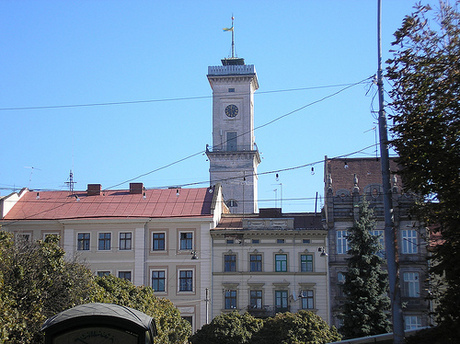Lviv Town Hall
Lviv Town Hall is the administrative building in the central part of Lviv. The first town hall in Lviv was made of wood and burned in the late XIV century. The new tower was founded in 1827 and was built in 1830-1835 in the style of Viennese classicism. The authors of the project are the architects Y. Markley, F. Thresher (or Treter), A. Vondrashek. The Town Hall is made of brick, four-story, square in plan, with patio. Above the town hall there raises the clock tower (made on the factory of V. Stil near Vienna).
Town Hall is the witness of the many historical events. In the Middle Ages there was a pillar of punishment in front of it. In 1564 he was executed the Moldavia monarch Tomsha, and in 1578 - the leader of the Cossack and peasant uprising Ivan Podkova.
In 1848, during the revolutionary events in Lviv the city center was under fire by the Austrian artillery and the Town Hall was badly damaged, its original tower collapsed. In 1851 the building was repaired, the dome was replaced to the toothed one, as in the medieval towers. In 1852 on the tower there was set a new clock. Since 1939 the building is the location place for the Lviv City Council.
The entrance to the Town Hall is free, on its tower there is situated the paid observation deck, which overlooks the city. The current building of the Lviv City Hall was constructed in the Viennese Classicist style in the middle of the 19th century. For only 3 UAH (47 eurocents), one can climb 350 wooden stairs and have the pleasure of viewing all the beauty that the city affords from the gallery of the City Hall tower.
This City Hall is the fourth in the city’s history. The first two were destroyed by fire, the third Renaissance one was erected in 1619. It was the City Hall that became the historical herald of the city’s fate. During a fierce storm on the 9th of July 1672 the lion-shaped weather vane came off the tower and fell down, facing East. The same year the city was under Turkish siege. The second time the weather vane came off was in 1704, just before Lviv was captured by the army of Swedish King Karl 1826 became a fatal year for the City Hall itself. At the very moment when a commission sitting in the City Hall was drawing up a report on the building’s reliability, the City Hall collapsed, burying eight citizens under its ruins.
Foundations of the new City Hall were laid in a year; its construction was finished in 1835. The construction cost an enormous amount of money for that time – half a million crowns. The new City Hall had 9 halls and 156 rooms. Apart from the magistrate it housed a school, a savings bank, municipal archives, and other establishments. The tower grew to a height of almost 65 metres, and a clock made in the workshop of the Viennese Polytechnic was mounted in it. The fate of the new City Hall was not unclouded either: during the revolution of 1848 as a result of artillery battering the tower caught fire and its dome fell. The building was renovated in 1851 in its current form: the City Hall tower, instead of being topped by a dome, was completed with the serrated edge of early medieval towers. A new clock, made in 1852 at the Viennese Stil Factory, has been performing its duty for Lvivites without fail for half a century; the tolling of its bells is an organic part of the city’s aura. If you reach the gallery of the City Hall right at the moment when the clock strikes and make a wish, it will certainly come true
In 1883 the City Hall was connected via telephone wires to the fire brigade and other local establishments. The city magistrate resided in the City Hall, and after the right of self-government was granted to Lviv in 1870, the city president resided here. On the 1st of November 1919 the national blue-and-yellow flag was hoisted on the City Hall tower for the first time; since the 3rd of April 1990 the national flag of Ukraine has been permanently waving in the sky above Lviv. Nowadays, as in times past, the City Council of Lviv resides in the building; this, however, does not prevent tourists from walking along its corridors and climbing to its highest point.




